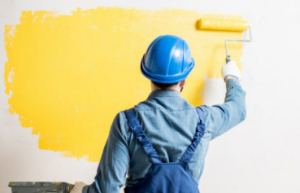How Long Does Exterior Paint Last in Florida’s Weather?





 If you’re considering hiring a painting contractor to paint your home’s exterior and you live in Florida—especially in areas like Palm Harbor—you’ve likely asked the important question: How long will this paint job actually last? Florida’s tropical climate brings sun, humidity, rain, and salty air that can put even the best paint to the test. While a fresh coat of paint can dramatically boost your home’s curb appeal and provide essential protection, it’s crucial to understand what you’re up against in the Sunshine State.
If you’re considering hiring a painting contractor to paint your home’s exterior and you live in Florida—especially in areas like Palm Harbor—you’ve likely asked the important question: How long will this paint job actually last? Florida’s tropical climate brings sun, humidity, rain, and salty air that can put even the best paint to the test. While a fresh coat of paint can dramatically boost your home’s curb appeal and provide essential protection, it’s crucial to understand what you’re up against in the Sunshine State.
In this comprehensive guide, we’ll explore:
- The environmental factors unique to Florida
- How long different surfaces typically hold up
- What influences paint longevity
- Signs it’s time to repaint
- Pro tips for maximizing your exterior paint’s life
- Why professional application matters
- Whether a high-end paint job is worth the investment
- Which colors last longest in Florida
By the end, you’ll know exactly how to protect your investment and ensure your home looks beautiful for years to come.
Florida’s Unique Climate Challenges
Unlike most parts of the country, Florida poses extreme challenges for exterior paint longevity. In Palm Harbor and other coastal cities, homes face near-constant environmental stress from multiple fronts:
1. Intense UV Rays
Florida enjoys sunshine nearly year-round. But those relentless ultraviolet rays accelerate fading, drying, and breakdown of the paint’s surface—especially on south- and west-facing walls.
2. High Humidity
The state’s high humidity doesn’t just make it feel warmer. Moisture in the air can seep into cracks and pores in the paint film, leading to blistering, mold growth, and eventual peeling.
3. Salt Air
If you live near the Gulf of Mexico or any saltwater inlet, airborne salt can corrode exterior surfaces, causing paint to bubble and fail prematurely.
4. Frequent Rain and Storms
Heavy rains, afternoon thunderstorms, and hurricanes take a toll. Paint must resist water intrusion while also expanding and contracting with temperature swings and wind-driven rain.
Together, these factors drastically shorten the lifespan of exterior paint unless you choose the right products, prep thoroughly, and maintain properly.
How Long Does Exterior Paint Last in Florida?
The durability of exterior paint varies depending on the surface material, paint quality, and application process. Here’s a look at what you can typically expect in Florida:
|
Surface Type |
Average Lifespan (Florida) |
|
Stucco |
5–7 years |
|
Wood siding |
3–5 years |
|
Fiber cement board |
7–10 years |
|
Vinyl siding |
5–8 years |
|
Painted brick |
7–10 years |
Important note: These numbers assume good paint and basic prep. Using premium paint and professional application can push your paint job to the upper end of the spectrum—or even beyond.
Factors That Affect Paint Longevity in Florida
1. Paint Quality
Not all paints are created equal. In Florida, you need high-performance coatings with UV resistance, mildew inhibitors, and flexible formulas. Top-tier options include:
- Sherwin-Williams Duration®
- Benjamin Moore Aura®
- Behr Premium Plus Ultra®
These paints may cost more upfront, but they last longer, resist fading, and provide better adhesion.
2. Surface Preparation
The biggest mistake DIYers and low-budget contractors make? Skipping prep work. Proper surface prep includes:
- Pressure washing to remove mildew, dirt, and salt
- Patching stucco or replacing rotted wood
- Caulking cracks and gaps
- Applying high-bond primers
Without proper prep, even the best paint won’t last more than a few years.
3. Number of Coats
In Florida, one coat is never enough. You need a full primer plus two coats of paint to stand up to the elements. Skimping on coats will cost you in the long run.
4. Sun Exposure
Southern and western exposures get blasted with UV rays all year. These walls fade faster and may need touch-ups or repainting more often. Consider using extra UV protection on these surfaces.
5. Proximity to the Ocean
Living close to saltwater increases exposure to salt-laden air, which accelerates paint degradation. A professional familiar with coastal homes will select paints and primers designed for this environment.
How to Tell When It’s Time to Repaint
Even if your paint hasn’t reached the end of its projected lifespan, visible clues may suggest it’s time to repaint. Here are key signs:
- Fading colors—especially on sun-facing walls
- Chalking—a white, powdery film that rubs off on your hand
- Peeling or bubbling—a sign of moisture problems
- Cracks in stucco or siding—can lead to water infiltration
- Mildew stains—usually appear in shaded or north-facing areas
- Exposed wood trim—visible wear or discoloration
If you spot any of these issues, consult a professional painting contractor in Palm Harbor for an assessment. Early intervention can prevent further damage and higher repair costs.
How to Extend the Life of Your Exterior Paint in Florida
Maintaining your home’s exterior doesn’t have to be overwhelming. Just a few preventative steps each year can add years to your paint’s lifespan:
1. Annual Pressure Washing
Cleaning your home once a year helps remove salt, dirt, mildew, and other pollutants that wear away at paint. Be gentle with the pressure to avoid damaging the surface.
2. Seasonal Inspections
Look for signs of cracking, bubbling, or wood rot—especially after storms. Catching issues early makes repairs easier and extends the life of the paint.
3. Use Mold-Resistant Paint
Choose paints with built-in mold and mildew inhibitors. These are especially useful in damp or shaded areas that dry out more slowly.
4. Re-Caulk Every 3–5 Years
Keep seams and joints sealed to prevent water penetration. Water is one of the biggest enemies of exterior paint, particularly in wood-framed homes.
5. Avoid DIY Touch-Ups
Touch-ups often leave visible patches and may not bond well. Always use the same brand and finish of paint—or better yet, hire a pro to handle it correctly.
The Importance of Professional Application
In Florida, who you hire matters just as much as what paint you choose. A licensed and experienced painting contractor in Palm Harbor will:
- Choose paint suited for Florida’s coastal weather
- Apply coatings in the correct temperature and humidity range
- Properly prep all surfaces to manufacturer standards
- Offer labor and material warranties
- Handle HOA approvals and local regulations if needed
In contrast, bargain contractors often use lower-grade materials, rush jobs, or skip surface prep—leading to premature failure and more money out of your pocket down the road.
Cost vs. Value: Is a High-End Paint Job Worth It?
While a professional exterior paint job in Florida might cost between $3,000 and $7,000, it offers excellent return on investment. Here’s why:
Benefits of a Quality Exterior Paint Job:
- Boosts curb appeal instantly
- Protects your home from moisture, pests, and UV damage
- Reduces maintenance costs over time
- Increases resale value
Premium paint plus professional labor might cost more upfront, but it can extend the lifespan of your paint to 10+ years—especially on durable surfaces like stucco and cement board.
Bonus: Best Paint Colors for Florida Homes
Paint color isn’t just about aesthetics in Florida—it also affects longevity. Lighter colors reflect sunlight and heat, reducing the rate of fade and minimizing heat buildup.
Long-Lasting Exterior Color Recommendations:
- Soft beige
- Warm white
- Pale gray
- Light sand
- Sky blue
- Cream
Avoid dark shades like charcoal, navy, or deep reds. These absorb more heat, fade faster, and may promote chalking or cracking in hot weather.
Conclusion: Protecting Your Home with Smart Choices
Florida’s coastal environment is harsh—but with the right paint, proper preparation, and regular maintenance, your exterior paint can last far longer than the average homeowner expects. Instead of cutting corners, focus on investing wisely:
- Choose high-quality, Florida-specific paint formulas
- Hire experienced, reputable contractors
- Maintain your exterior yearly with cleanings and inspections
- Repaint proactively when early signs of wear appear
By doing so, you’ll not only preserve your home’s beauty and structural integrity, but you’ll also avoid the expense of constant touch-ups or full repaints every few years.
Coming Up Next: What’s the Best Time of Year to Paint in Florida?
Timing matters just as much as technique when painting in Florida’s unpredictable weather. Our next blog post explores the best seasons and specific months to schedule your exterior paint job—so you can achieve optimal adhesion, curing, and durability. Stay tuned!

100% Satisfaction Guarantee

Licensed and Insured

Color Consultation

3 Year Warranty
Services

Our team of experts does popcorn ceiling removal and wallpaper removal. We also do drywall and stucco repairs as well as texturing, soffit and fascia repair.
Painting Service Locations

How long does it take to paint my house?
What is included with your free estimate?
All of our estimates include a fully detailed scope of the work to be completed. You will receive a report with a breakdown of the cost and time estimated for your project.
How do I get my project scheduled?
Simply follow the steps in the estimate to schedule or give us a call, text, or email. Whichever is convenient for you works for us.
Why does a house have to be pressure washed before painting?
If you’re planning to paint the exterior of your home, you may be wondering why pressure washing is such an important step. After all, a little dirt and grime shouldn’t stop the paint from sticking, right? Unfortunately, it’s not that simple. Over time, dirt, mildew, and other pollutants can build up on the surface of your home, causing the paint to chip and peel. Pressure washing removes this build-up, giving the new paint a clean surface to adhere to. In addition, pressure washing also helps to remove any chalky residue left behind by old paint. This ensures that the new paint will have a smooth, even finish. For these reasons, it’s always best to have your home professionally pressure washed before painting
Item How often does a house need to be repainted?
The frequency with which a house exterior needs to be repainted depends on a number of factors, including the type of paint used, the climate, and the level of exposure to sun and rain. In general, however, most experts recommend repainting every three to five years. High-quality paints that are properly applied can last for about 10 years, while lower-quality paints may last less. The climate also plays a role in how often a house needs to be repainted. For example, homes in areas with high humidity levels may need to be repainted more frequently than homes in dry climates. Exposure to sun and rain can also shorten the lifespan of paint, so homes that are exposed to these elements may need to be repainted more often than those that are not. Ultimately, the best way to determine how often a house exterior needs to be repainted is to consult with a painting contractor who can assess the condition of the paint and make a recommendation based on individual circumstances.
Trustindex verifies that the original source of the review is Google. I want to thank Curb Appeal Pros for doing an amazing job of painting the exterior of my house. Sending a big shout out to owner, Jay McGarrity, for being so patient, professional, and fair with the pricing, timing, and color choices. When I changed my mind about the original colors that I had selected, Jay came back to my house twice (including Father's Day) to test some different paint samples I had purchased from Sherwin Williams. The final result was exactly what I wanted and my house looks fabulous! I will hire Curb Appeal Pros again when I am ready to have some interior painting done.Trustindex verifies that the original source of the review is Google. They repaired stucco on the fireplace exterior and outside window sills, pressure washed the house, and my shed in the backyard. Painted the house and all fascia and soffits. They did an outstanding job !! Would not hesitate to use them again.Trustindex verifies that the original source of the review is Google. Amazing job filled in all the settling cracks and made the house look amazing would highly recommend them to anyone who’s looking to fix their home up.Trustindex verifies that the original source of the review is Google. What a great experience. Joey worked with me to get the house painted in between projects so I could have the house painted before my new gutters were put in. I didn't have to be home, which was a plus. The painter Angel and Nathen which I got meet at the end of the project were friendly and professional. I would definitely recommend Curb Appeal. Joyce Walter.Trustindex verifies that the original source of the review is Google. We recently hired Curb Appeal Pros to paint our living room,dining room, family room and kitchen. They were easily up to the task. I had different colors,different paint finish’s, texturing and an accent wall as well. Angel and his crew did an amazing job.They were organized ,pleasant ,and had my entire house finished in less than 3 days. They removed all the large furniture and carefully put it back in its place perfectly after the job was done ! The owner was hands on and was easy to reach and made sure that my questions were answered without delay or hesitation. My house looks amazing . They went the extra mile in every way and we are so grateful . Thank you Curb Appeal for a job well done. I recommend you contact them for all your painting needs.Trustindex verifies that the original source of the review is Google. Curb Appeal Pros is a 'one stop shop'. They recently painted our house and installed ledger stone on the exterior of our house. After the job was completed, we contacted Jay McGarrity about a detail. Jay immediately responded and came back to the house even after payment! The end result of their work is beautiful. Jay and his Team are a pleasure to work with.Trustindex verifies that the original source of the review is Google. reliable, great work, honest pricing. i highly recommend these pplTrustindex verifies that the original source of the review is Google. Fair price and good work. What more can you ask for?Trustindex verifies that the original source of the review is Google. Excellent job. Jay was quick to respond to everything we asked, kept us well informed and made sure the job was done exactly how we asked. Will definitely recommend to everyone who asks, which we have already done several times as of this review. Truly thankful for the professionalism when so many companies now lack it!
Request An Estimate

copyright @2025 all rights reserved | Privacy-policy